-
Paper Information
- Paper Submission
-
Journal Information
- About This Journal
- Editorial Board
- Current Issue
- Archive
- Author Guidelines
- Contact Us
Journal of Wireless Networking and Communications
p-ISSN: 2167-7328 e-ISSN: 2167-7336
2015; 5(1): 9-18
doi:10.5923/j.jwnc.20150501.02
Space Time Block Codes Using Multiple Transmitting Antennas
Satyanarayana Murthy Nimmagadda1, Sri Gowri Sajja2, Prabhakara Rao Bhima3
1ECE Dept, VR Siddhartha Engg. College, Kanuru, Vijayawada, Andhraprdesh
2ECE Dept, SRK Institute of Technology, Vijayawada
3ECE Dept, I/C Vice Chancellor, JNTUK, Kakinada
Correspondence to: Satyanarayana Murthy Nimmagadda, ECE Dept, VR Siddhartha Engg. College, Kanuru, Vijayawada, Andhraprdesh.
| Email: |  |
Copyright © 2015 Scientific & Academic Publishing. All Rights Reserved.
The performance of space – time block codes for transmission over Quasi – static Rayleigh flat fading channels using multiple transmit antennas is considered. Data is prearranged using a space – time block code, which is split in to parallel streams via simultaneously transmitted transmit antennas. The received signal at each receive antenna is a linear superposition of the n transmitted signals perturbed by noise. Maximum likelihood decoding is carried out by dividing the signals transmitted from different antennas. This uses the orthogonal structure of the space-time block code and gives a maximum-likelihood decoding algorithm, which is based only on linear processing at the receiver. The performance of Space Time Block Codes for 1 bit/sec/HZ and 2 bits/sec/HZ using BPSK,QPSK Modulation Schemes for four and eight transmit antennas with code rate of 1/2 and 4/7 is evaluated. By increasing the code rate of the system using four transmit antennas, significant gains are achieved compared to existing system.
Keywords: Diversity, (Generalized) complex orthogonal designs, Space – time block codes
Cite this paper: Satyanarayana Murthy Nimmagadda, Sri Gowri Sajja, Prabhakara Rao Bhima, Space Time Block Codes Using Multiple Transmitting Antennas, Journal of Wireless Networking and Communications, Vol. 5 No. 1, 2015, pp. 9-18. doi: 10.5923/j.jwnc.20150501.02.
Article Outline
1. Introduction
- The newly emerging technologies in the field of smart antennas have resulted in the development of space time coding techniques. These techniques are much more effective than conventional diversity techniques by employing information coding and signal processing simultaneously both at the transmitter and receiver [1], [2], [3], and [4]. Multiple antennas also introduce antenna diversity (also known as space diversity) into the communication system. The major problem with the receiver diversity is the cost, size and power consumption constraints. For this reason, transmit diversity scheme are very attractive. Space-time block codes is a transmit diversity scheme with optional receive diversity to accomplish high data rate and to improve the reliability of a wireless channel. Since the pioneer work of Alamouti orthogonal space-time block coding for two transmit antennas (OSTBC) [5] has shown remarkable performance due to their low decoding complexity. According to V. Tarokh, H. Jafarkhani, and A. R. Calderbank when three or four transmit antennas were considered, the maximum symbol transmission rate of the complex OSTBC with the linear processing was 3/4 [6-8]. Due to this drawback Quasi orthogonal space-time codes relax the orthogo nality constraint of to enable rate-one transmission, at the expense of an increase in decoding complexity. For example, quasi orthogonal codes for four antennas were proposed independently by Jafarkhani [9], C. F. Mecklenbrauker and M. Rupp [10] Tirkkonen - Boariu-Hottinen [11] and Papadias-Foschini [12].
2. Existing GCOD Space Time Block Codes for N = 4 Transmit Antennas
- Tarokh, Jafarkhani, and Calderbank [5] Proposed Complex orthogonal designs for four transmit antennas with code rate ½ based on above is given by
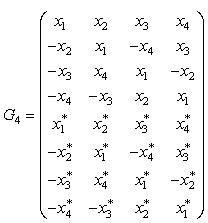 An STBC is defined by p * n code matrix, where p represents the number of time intervals for transmitting k symbols, resulting in a code rate of R = k/p. At the receiver to recover symbols Maximum likelihood decoding algorithm is used.
An STBC is defined by p * n code matrix, where p represents the number of time intervals for transmitting k symbols, resulting in a code rate of R = k/p. At the receiver to recover symbols Maximum likelihood decoding algorithm is used.3. New GCOD Space Time Block Codes for N = 4 Transmit Antennas
- We presented GCOD Space time block codes for four transmit antennas, which can send 4 information symbols in a block of 8 channel uses and hence have rate ½ and G4 complex orthogonal design as follows:
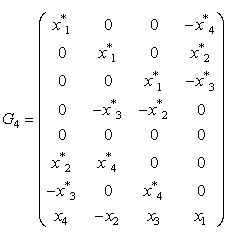 The received signals during eight time slots can be expressed as
The received signals during eight time slots can be expressed as 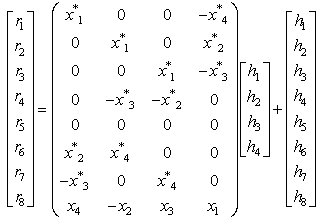 At the receiver Maximum likelihood decoding is achieved in a simple way through decoupling of the signals transmitted from different antennas to recover original signals
At the receiver Maximum likelihood decoding is achieved in a simple way through decoupling of the signals transmitted from different antennas to recover original signals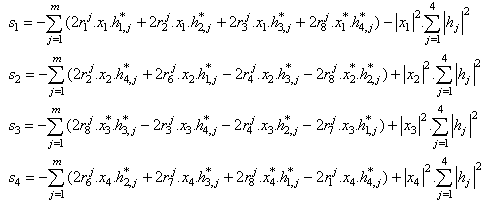 We presented GCOD Space time block codes for four transmit antennas, which can send 4 information symbols in a block of 7 channel uses and hence have rate 4/7 and G4 complex orthogonal design as follows:
We presented GCOD Space time block codes for four transmit antennas, which can send 4 information symbols in a block of 7 channel uses and hence have rate 4/7 and G4 complex orthogonal design as follows: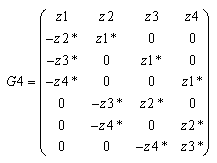 The received signals during eight time slots can be expressed as
The received signals during eight time slots can be expressed as 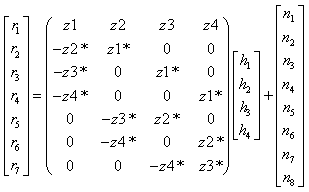 At the receiver Maximum likelihood decoding is achieved in a simple way through decoupling of the signals transmitted from different antennas to recover original signals
At the receiver Maximum likelihood decoding is achieved in a simple way through decoupling of the signals transmitted from different antennas to recover original signals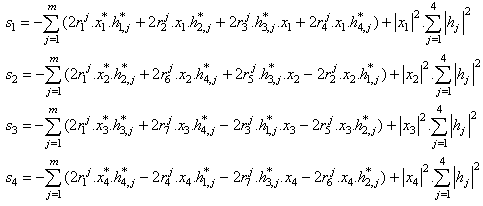
4. New GCOD Space Time Block Codes for N = 8 Transmit Antennas
- The QOSTBC below matrix provides a rate R = 3/4 by transmitting six symbols in eight time slots.
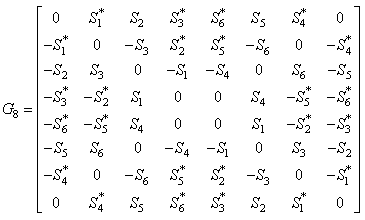 The corresponding non orthogonal condition gives with G8 as follows
The corresponding non orthogonal condition gives with G8 as follows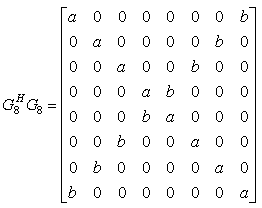
 Decoding analysis:In this design the transmission matrix columns are divided into groups. While the columns within each group are not orthogonal to each other, different groups are orthogonal to each other. We call such a structure a quasi-orthogonal design. We show that using a quasi-orthogonal design, pairs of transmitted symbols can be decoded separately. We were decoding when there is one user.. Assuming perfect channel state information is available; the receiver computes the decision metric
Decoding analysis:In this design the transmission matrix columns are divided into groups. While the columns within each group are not orthogonal to each other, different groups are orthogonal to each other. We call such a structure a quasi-orthogonal design. We show that using a quasi-orthogonal design, pairs of transmitted symbols can be decoded separately. We were decoding when there is one user.. Assuming perfect channel state information is available; the receiver computes the decision metric  Over all possible symbols to replace
Over all possible symbols to replace  with C and to decide in favour of constellation symbols that minimize the sum. Since we have only one user and for simplicity we specify one receiver antenna, and do not mention indexing of group of or receive antenna. Simple algebraic manipulation shows that ML decoding. We proved that this metric is the sum of
with C and to decide in favour of constellation symbols that minimize the sum. Since we have only one user and for simplicity we specify one receiver antenna, and do not mention indexing of group of or receive antenna. Simple algebraic manipulation shows that ML decoding. We proved that this metric is the sum of  components each consisting of only the variable
components each consisting of only the variable  Indeed, if the metric (4.4) is expanded, the cross terms involving
Indeed, if the metric (4.4) is expanded, the cross terms involving  are canceled out since
are canceled out since  th and
th and  th columns of
th columns of  are orthogonal to each other. Thus the sum has
are orthogonal to each other. Thus the sum has  components involving only the variable
components involving only the variable 
 It can be further proved that each component can be computed using only linear processing [3].In this code if we define
It can be further proved that each component can be computed using only linear processing [3].In this code if we define  as the
as the  column, we have
column, we have 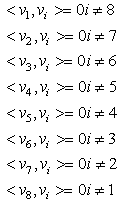 | (11) |
 is the inner product of vectors
is the inner product of vectors  and
and  Therefore, the subspace created by
Therefore, the subspace created by  and
and  is orthogonal to the subspace created by
is orthogonal to the subspace created by  and
and  . and the subspace created by
. and the subspace created by  and
and  Using this orthogonality, the maximum-likelihood decision metric can be calculated as the sum of the three terms
Using this orthogonality, the maximum-likelihood decision metric can be calculated as the sum of the three terms  where
where  is independent of
is independent of 
 is independent of
is independent of  and
and  is independent of
is independent of  In other words first the decoder finds the pair
In other words first the decoder finds the pair  that minimizes the
that minimizes the  among all possible
among all possible  pairs, next the decoder selects the pair
pairs, next the decoder selects the pair  which minimizes the
which minimizes the  and next the decoder selects the pair
and next the decoder selects the pair  which minimizes the
which minimizes the  This reduces the complexity of decoding without sacrificing the performance. The pairs
This reduces the complexity of decoding without sacrificing the performance. The pairs  can be decoded separately and the scheme is pair wise decidable.
can be decoded separately and the scheme is pair wise decidable.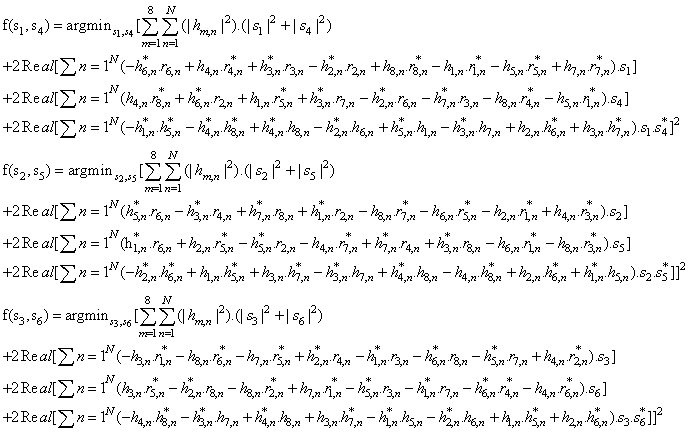
5. Results
- Existing system
 Proposed system
Proposed system
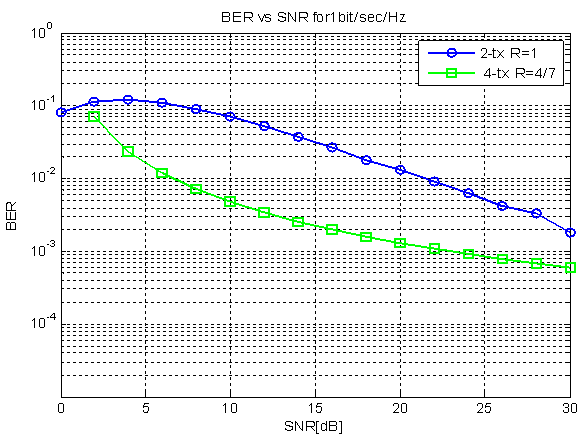 | Figure 1. BER of STBC for four tx.antennas with code rate 4/7 of 1bit/sec/Hz |
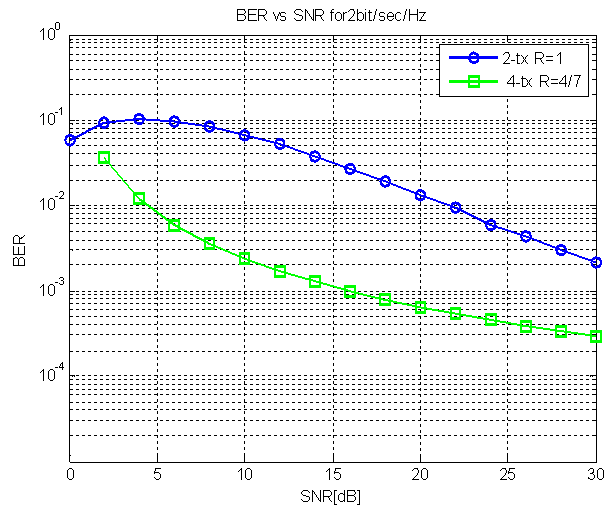 | Figure 2. BER of STBC for four tx.antennas with code rate 4/7 of 2bit/sec/Hz |
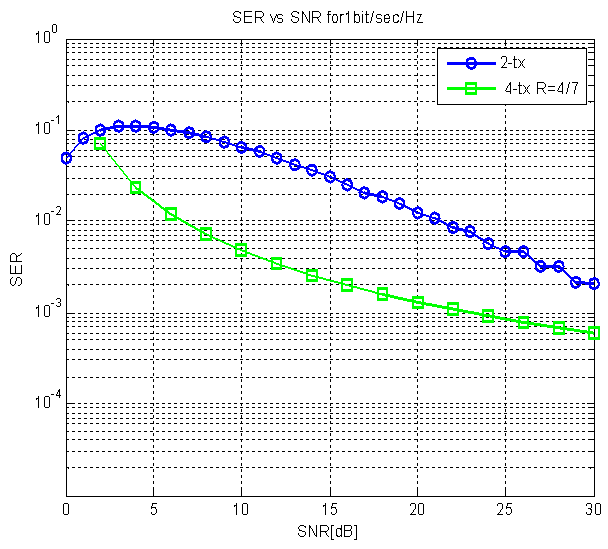 | Figure 3. SER of STBC for four tx.antennas with code rate 4/7 of 1bit/sec/Hz |
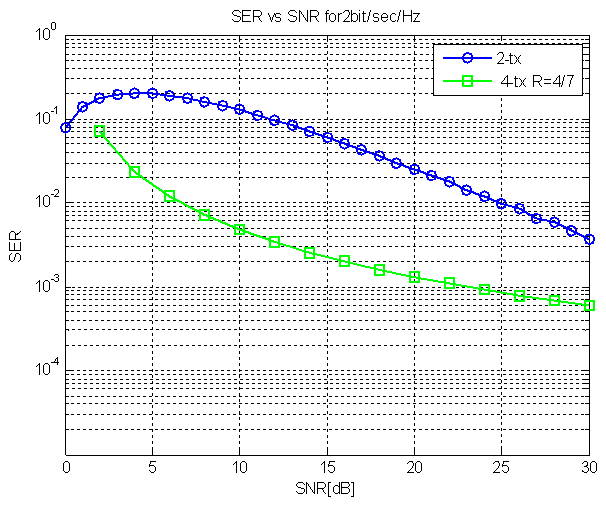 | Figure 4. SER of STBC for four tx.antennas with code rate 4/7 of 2bit/sec/Hz |
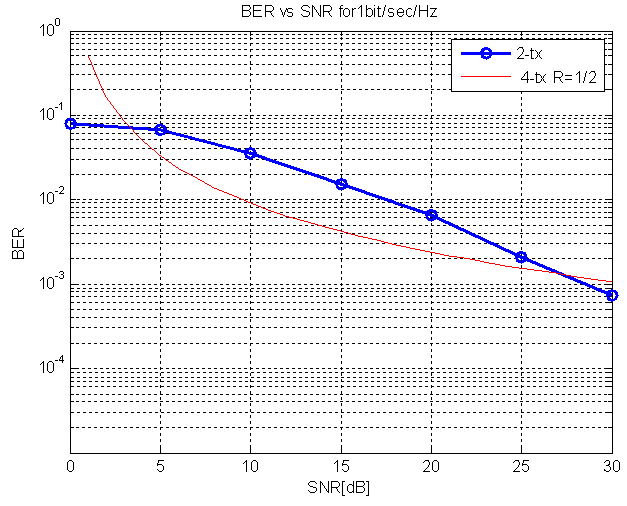 | Figure 5. BER of STBC for four tx.antennas with code rate ½ of 1 bit/sec/Hz |
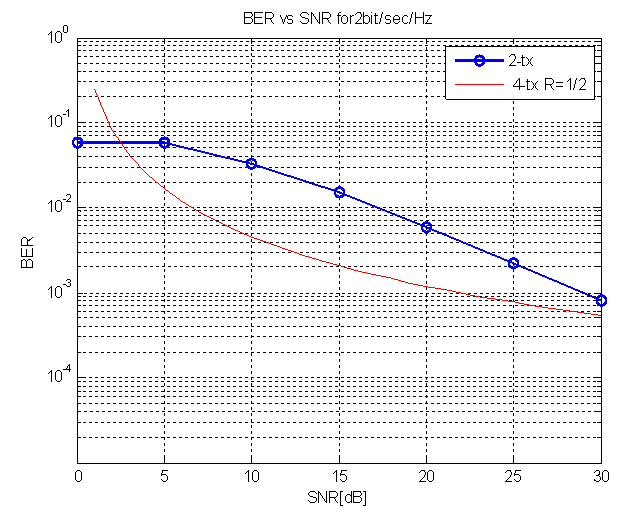 | Figure 6. BER of STBC for four tx.antennas with code rate ½ of 2 bit/sec/Hz |
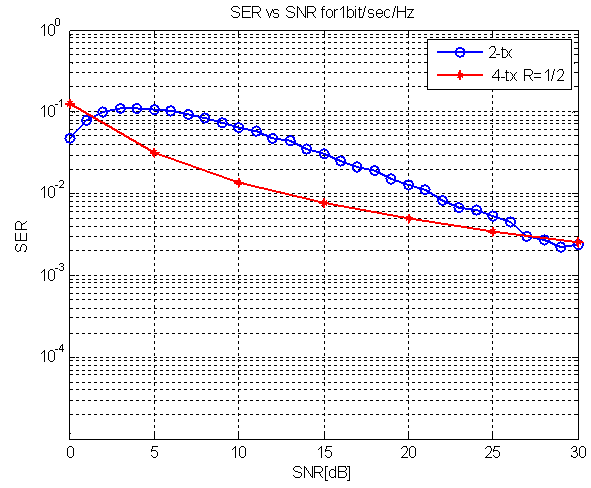 | Figure 7. SER of STBC for four tx.antennas with code rate ½ of 1 bit/sec/Hz |
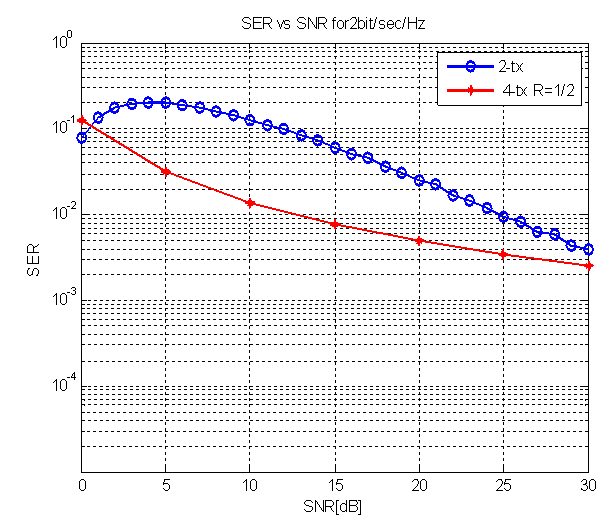 | Figure 8. SER of STBC for four tx.antennas with code rate ½ of 2 bit/sec/Hz |
 , significant gain achieved is 2.0db.New systemSimulation results of the performance of Eight transmit antenna with jafarkhani four transmit antenna for Bit error probability vs signal to noise ratio at
, significant gain achieved is 2.0db.New systemSimulation results of the performance of Eight transmit antenna with jafarkhani four transmit antenna for Bit error probability vs signal to noise ratio at , significant gain achieved is 4.0db.
, significant gain achieved is 4.0db.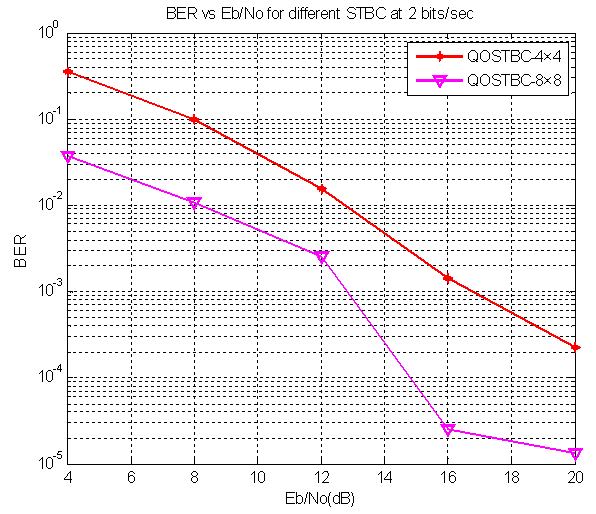 | Figure 9. Comparison of QOSTBC 4X4 with 8X8 QOSTBC |
6. Conclusions
- The performance of Space Time Block Codes for 1 bit/sec/HZ and 2 bits/sec/HZ using BPSK, QPSK Modulation Schemes for four transmit antennas with code rate of 1/2 and 4/7 is evaluated. By increasing the code rate of the system using four transmit antennas, significant gains are achieved compared to existing system. The performance of 4*4 QOSTBC with 8*8 QOSTBC for 2 bits/sec/HZ using QPSK Modulation Schemes for four and eight transmit antennas with code rate of 1 and 3/4 is evaluated. By increasing number of transmit antennas (8*8 QOSTBC) significant gains are achieved compared to existing system (4*4 QOSTBC).
 Abstract
Abstract Reference
Reference Full-Text PDF
Full-Text PDF Full-text HTML
Full-text HTML